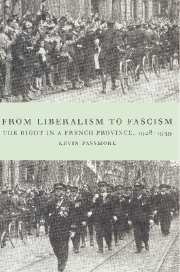Book contents
- Frontmatter
- Contents
- List of illustrations
- Preface
- List of abbreviations
- 1 Introduction
- 2 From France to the Rhône
- 3 Urban society in the Rhône
- 4 Rural society in the Rhône
- 5 The crisis of the right I: 1928–1932
- 6 The impact of the economic crisis
- 7 The crisis of the right II: 1932–June 1936
- 8 The Croix de Feu
- 9 The right and the Popular Front
- 10 Conclusion
- Appendix 1 Equations for multiple regressions
- Appendix 2 The conservative deputies of the Rhône, 1928–1940
- Select bibliography
- Index
6 - The impact of the economic crisis
Published online by Cambridge University Press: 23 December 2009
- Frontmatter
- Contents
- List of illustrations
- Preface
- List of abbreviations
- 1 Introduction
- 2 From France to the Rhône
- 3 Urban society in the Rhône
- 4 Rural society in the Rhône
- 5 The crisis of the right I: 1928–1932
- 6 The impact of the economic crisis
- 7 The crisis of the right II: 1932–June 1936
- 8 The Croix de Feu
- 9 The right and the Popular Front
- 10 Conclusion
- Appendix 1 Equations for multiple regressions
- Appendix 2 The conservative deputies of the Rhône, 1928–1940
- Select bibliography
- Index
Summary
For Pierre Milza one of the principal reasons for the failure of fascism in France was the lesser gravity of the economic crisis compared to Italy and Germany. There was therefore no mobilisation of the ‘most stable elements’ of society, no feeling of ‘uncertainty’ sufficient to lead to a demand for power on the part of extremist movements, and no failure of the ruling elites. The middle classes remained faithful to republican values and institutions. Even partisans of authority like La Rocque were ultimately committed to the Republic. This argument shares with the ‘stalemate society’ thesis the assumption of a powerful common culture, and indeed the view that the Croix de Feu represented merely a Catholic and authoritarian version of the Radical Party, equally committed to maintaining the status quo. This interpretation confuses the conditions which lead to the emergence of a fascist movement with those which produce a fascist regime. It also assumes that a fascist regime can emerge from only one set of conditions, a view which rules out the possibility of an unsuccessful fascist movement. In fact a social crisis may produce several varieties of right-wing authoritarianism. In Germany crisis gave birth to the Stahlhelm, the Strassers, Hitler and von Papen, and led the Catholic Centre Party to salute ‘führer Brüning’. In France the crisis brought about a movement for reform of the state within the parliamentary right, accentuated the populism of some in the Fédération républicaine and produced the Croix de Feu, PSF and PPF, and even caused some parts of the right to turn to the Popular Front.
- Type
- Chapter
- Information
- From Liberalism to FascismThe Right in a French Province, 1928–1939, pp. 163 - 185Publisher: Cambridge University PressPrint publication year: 1997

